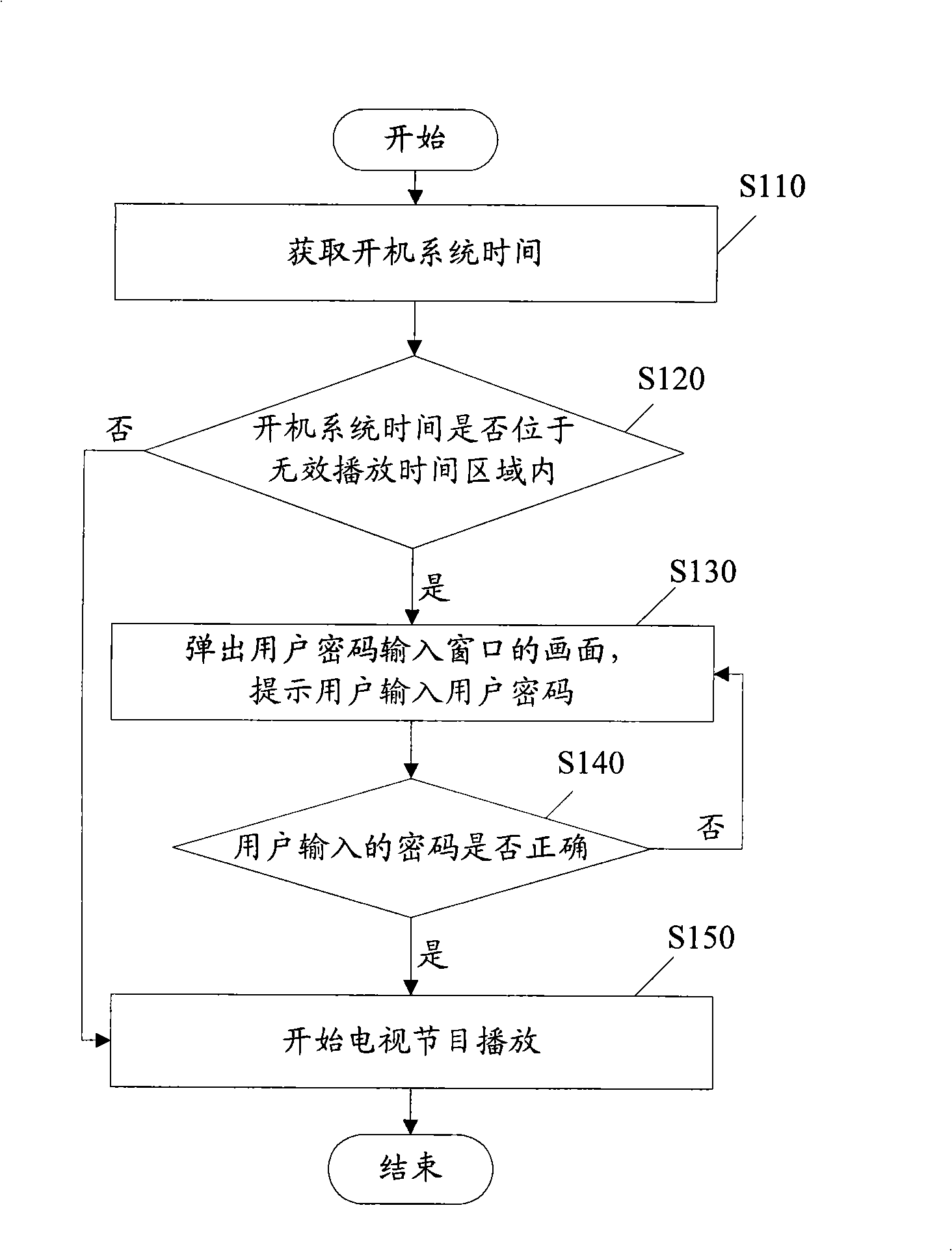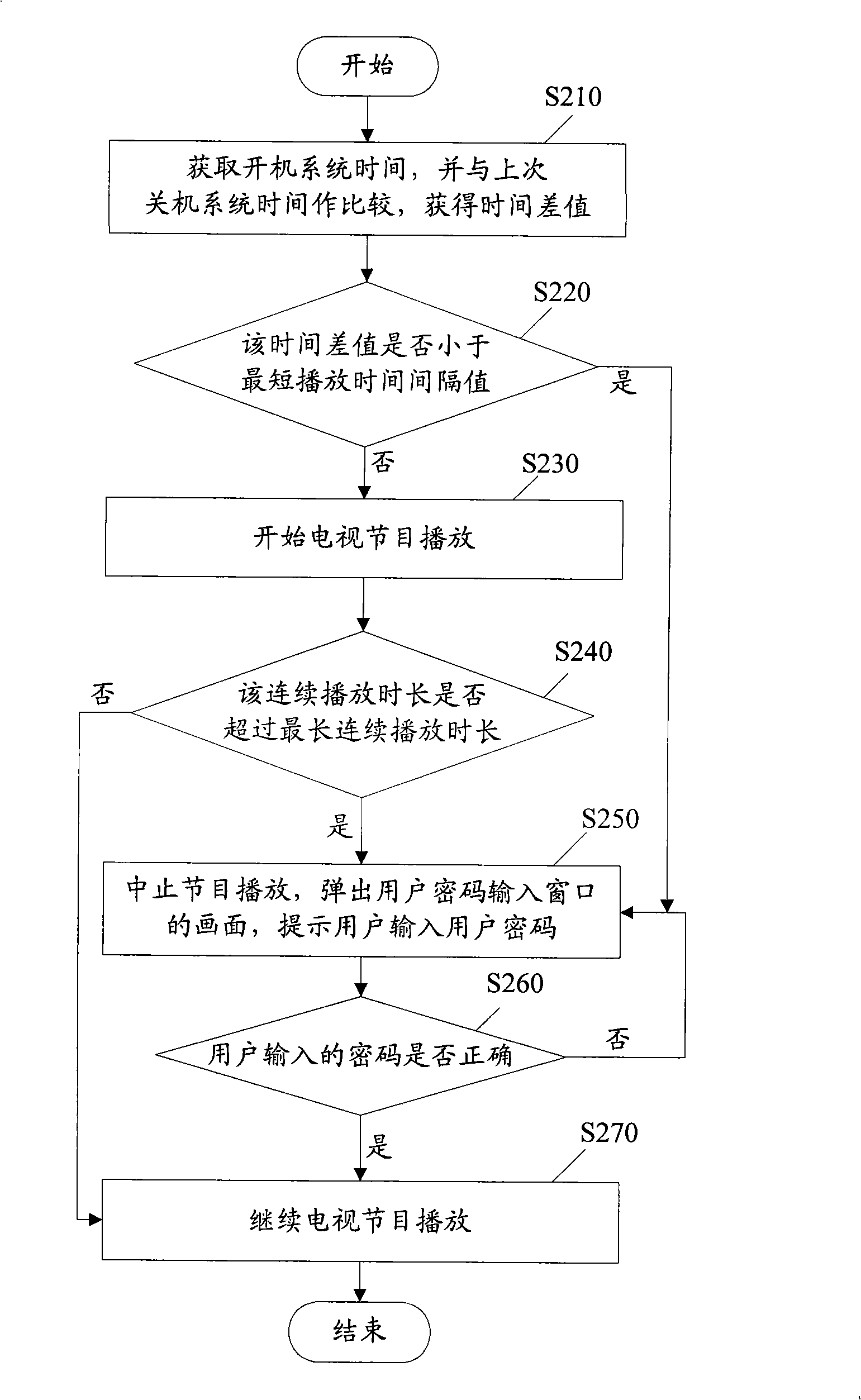Digital television time lock controlling equipment and method
A time-locking, digital TV technology, applied in color TV parts, TV system parts, TVs, etc., can solve the time-lock change setting is complicated, can not reach the time limit, only set to 8:00-20 :00 and other issues, to achieve the effect of flexible time control strategy, good practicability, and convenience for users
- Summary
- Abstract
- Description
- Claims
- Application Information
AI Technical Summary
Problems solved by technology
Method used
Image
Examples
Embodiment 1
[0032] Please refer to figure 1 , is a schematic flow chart of this embodiment. This embodiment includes the following steps:
[0033] Step S110: the user starts the system, and obtains the time of the system starting from the set-top box (STB).
[0034] Step S120: Determine whether the start-up system time is within the preset invalid playing time zone, if so, it indicates that the current time period is the time period set by the user not to be able to watch TV programs, go to step S130, otherwise go to step S150.
[0035] Wherein, the invalid playing time area can be set and modified according to the user's own needs after the user enters the user menu after the power is turned on.
[0036] Step S130: A user password input window pops up on the digital TV, prompting the user to input the first user password to release the time lock.
[0037] Step S140: After the user inputs the user password through an input device, such as a remote control, determine whether the user pa...
Embodiment 2
[0042] Please refer to figure 2 Shown is a schematic flow chart of this embodiment. This embodiment is aimed at a time-locked control method that mainly takes the continuous playing duration as the control object during the playing process of a TV program. This embodiment includes the steps of:
[0043] Step S210: The user starts the system, obtains the system time of power-on through the set-top box (STB), compares the system time of power-on with the time of the last system power-off, and obtains the time difference between adjacent power-on and power-off operations.
[0044] Step S220: Determine whether the time difference is less than a preset minimum playing time interval (for example, 1 hour). If yes, go to step S250, otherwise, go to step S230.
[0045] The purpose of this step is to prevent the user from circumventing the control in this embodiment that takes the continuous playback duration as the control object by turning on and off the machine. Of course, if it i...
Embodiment 3
[0054] Because embodiment 1 focuses on the time lock control strategy that takes the time of the boot system as the control object when starting up, and embodiment 2 focuses on the time lock control strategy that takes the continuous broadcast time of digital TV as the control object during the TV program playing process, therefore, it can be Combining Embodiment 1 and Embodiment 2 organically, the perfect time-locked control of digital TV is carried out.
[0055] This implementation 3 is actually an optimized implementation of the organic combination of the implementation 1 and the implementation 2. Please combine figure 1 and figure 2 , to elaborate on this implementation 3. exist figure 1 After the step S160, the digital TV has started playing normal TV programs, and this step is actually equivalent to figure 2 In step S230, start counting the continuous playing time, and start the time lock control strategy with the digital TV continuous playing time as the control o...
PUM
 Login to View More
Login to View More Abstract
Description
Claims
Application Information
 Login to View More
Login to View More - R&D
- Intellectual Property
- Life Sciences
- Materials
- Tech Scout
- Unparalleled Data Quality
- Higher Quality Content
- 60% Fewer Hallucinations
Browse by: Latest US Patents, China's latest patents, Technical Efficacy Thesaurus, Application Domain, Technology Topic, Popular Technical Reports.
© 2025 PatSnap. All rights reserved.Legal|Privacy policy|Modern Slavery Act Transparency Statement|Sitemap|About US| Contact US: help@patsnap.com


